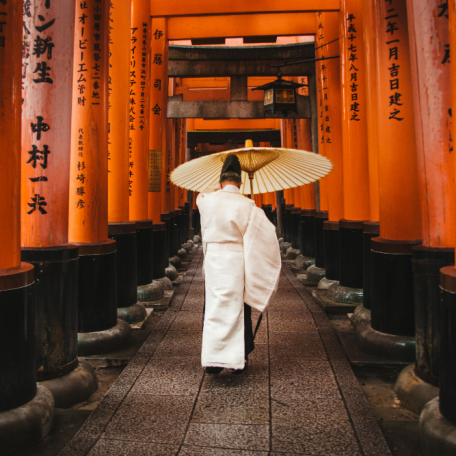SEASONAL FALL BEERS – TASTE SENSATIONS & FOOD PAIRINGS
Oct 22, 2022
BY David Willis

“The four seasons”. This is one of the more common responses when picking the brains of any Japanese about what the quintessential essence of Japan is. Needless to say, changes in our climate have shortened the fall season. However, it remains one of the more distinct periods on the Japanese calendar. Not least in terms of the cuisine and alcohol on offer. Beer is no exception and as early as August the largest alcohol producers begin releasing their seasonal autumnal lineups. As with most products, Japanese manufacturers tend to imitate the competition, resulting in beer can designs that cross over and blend into each other. The various tastes that Asahi, Suntory, and Kirin come up with are still quite different. What one beer chemist views as the essential autumnal taste does not necessarily match the palette of their peers.

Kohaku no Aki (琥珀の秋) or Amber Autumn from Suntory is part of their Rich Malt range and is their autumn offering. Rich Malt is on the cheaper end of the price scale, with their flagship product Premium Malts being their most expensive beer. At six percent alcohol, like the other fall beers, it is on the stronger side. This year Kohaku no Aki certainly has the most beautiful can design, with rich red multilayered leaves popping out above the dark brown background. The kanji letters stand out in solid gold with a gradient of orange on the edges.
It has a deep amber colour that does its eloquent name justice. The nose has a light aroma that is neither offensive nor striking. A well-carbonated beer that fizzes on the tongue, the taste is light with bitter notes and lacking in any real sweetness. Easy to drink and without tasting as strongly alcoholic as some six percent beers, this delicious and well-priced product would pair well with some of the sweeter foods popular in the Japanese fall season. I would match it with some Kuri Gohan (栗ご飯) or chestnut rice since the sweetness and simple taste of that dish would balance well with the bitterness of the beer. If chestnuts in rice don’t appeal to your senses, a baked sweet potato or Yaki Imo (焼き芋) would definitely be delicious when washed down with Kohaku no Aki.

Asahi’s autumn beer has a more playful name than the other two. Aki no Utage (秋の宴), which translates directly as Autumn Banquet uses navy blue as the backdrop in its can design to symbolise the evening sky. A yellow moon with falling red leaves and blowing gold wheat lend it an almost textural feel that reminds one of the craft towels you might buy in an artisanal Japanese souvenir shop. Aki no Utage has been released under Asahi’s Clear Asahi range, which, like its counterpart, Suntory Rich Malt, is a budget beer. Like Kohaku no Aki, the design makes this feel more extravagant than the price might suggest.
The colour has less depth and warmth but is still plainly different from the regular Clear Asahi. Like Suntory’s seasonal beer, this one also comes in at six percent alcohol. While having the bitterness of a fall item, Asahi’s creation is light and tastes similar to a regular crisp lager. The strength of the alcohol comes through, however, the palette is simple, with the nose barely registering at all. This all makes for Aki no Utage to be a perfect pairing with light but oily food such as grilled sanma (秋刀魚) or Pacific saury. Those with an understanding of Japanese kanji may notice that sanma contains the symbol for autumn. It is especially in the fall when this fish, with a similar taste to mackerel, is at its most delicious. If you prefer chicken, might I suggest Mizutaki Nabe (水炊鍋), a light kombu-based hotpot that is usually comprised of an abundance of tender chicken and autumnal vegetables?

Aki Aji (秋味), meaning autumn taste, has by far the simplest name and most generic can design of this year’s lineup. However, this one from Kirin has been around since 1991, which is proudly stated at the foot of the can. It must be said that the design overall is generic and has regressed in quality since the initial releases in the first decade of its introduction. The iconic Kirin logo sits proudly above the kanji, shrouded in a cloud of falling red and yellow leaves. While bold, it lacks the finesse and Japanese essence of Suntory and Asahi’s design work.
Visually this is the least autumnal-looking beer of our three. There is no amber depth and you might be mistaken for thinking this is one of Kirin’s permanent products. On the nose, there is the usual sweetness characteristic of lager without any hint of autumn hops. The taste is clear and refined without being especially strong, even with the six percent ABV. What is fascinating is that Aki Aji has been around the longest of the major fall beers, but lacks the charisma and fall palette of the other two. Due to the lightness in taste, I would recommend pairing this one with Oden (おでん), perhaps Japan’s most famous dish for the cold season. Daikon radish, konyaku, boiled eggs, chikuwa fish cake, and beef tendon are stewed in a light broth for hours to create a warming, pleasant dish that goes well with sake or beer. You will find oden all over Japan, even in convenience stores and sometimes at street food stalls. It is the quintessential fall food. Don’t forget to add karashi (からし) or Japanese mustard.

If I had to choose one fall beer in 2022 I would heartily recommend Suntory’s Kohaku no Aki. However, whichever one you go with, don’t forget those delicious Japanese dishes on the side.
To more deeply explore craft beer in Japan, join our expert guide on the Umeda Craft Beer & Bar Hopping Tour in Osaka!
Book your pocket wifi now to stay connected through your entire Japan Journey!

Be sure to get the JR Pass to make navigating Japan during your trip that much easier!

YOU MIGHT ALSO LIKE




